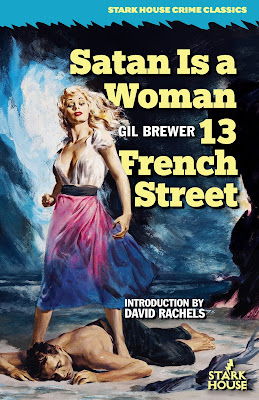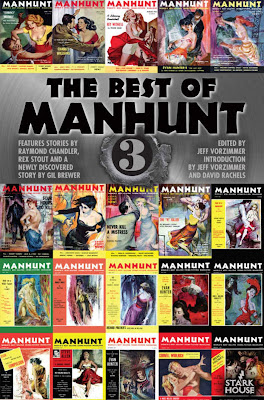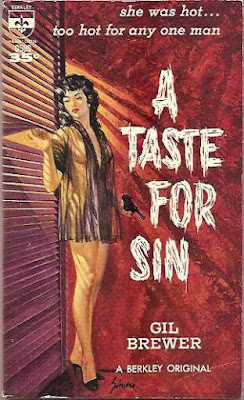Satan is a Woman from 1951 was Brewer’s first original novel and the beginning of his publishing relationship with the Fawcett Gold Medal imprint. The narrator is Larry, the manager of a tavern on the coast in St. Petersburg, Florida.
Larry’s a legit businessman, but his brother Tad is not. Tad recently killed two dudes in Tampa, and now the cops are looking for him. Tad is hiding out with Larry, and Larry is forced to lie to protect his brother — a problem he never invited. As Tad’s legal jeopardy worsens, it becomes clear that Larry needs to come up with money — a lot of it — for an attorney to save his big brother.
One afternoon a knockout blonde walks into Larry’s sleepy tavern. Her name is Joan Turner, and she’s a New Yorker who just rented a cabin next door to Larry’s bungalow. Everything about this initial interaction gives Larry the green light to make a move. Of course, you realize there must be a catch. After all, this is a Gil Brewer novel and you may have noticed the title…
Joan’s true colors come out gradually and watching Larry compromise his own ethics little by little was fascinating to read. There are some great plot twists that I won’t spoil for you here. Suffice it to say that this is a top-notch femme fatale noir story among the best Brewer had to offer.
Brewer’s second 1951 paperback, 13 French Street, was also his most popular book. The paperback sold over a million copies and sustained multiple printings from Fawcett Gold Medal in the U.S. and foreign publishers abroad. The short novel’s reputation as a sex-drenched story of lust and betrayal drew me in, and the pages just kept turning.
Our narrator is Alex Bland, and he’s on vacation visiting his old war-buddy, Verne. Upon arriving at Vern’s house at 13 French Street in a fictional southern town, he is greeted at the door by Verne’s impossibly sexy and flirtatious wife Petra, a dame who just oozes promiscuity. Although Alex has never met Petra before, they know each other from letters (paper emails) they’ve exchanged over the past five years. You see, Verne isn’t much of a letter writer, so he had his sexy wife write the letters to keep in touch with his best pal. (Note to dudes with sexy wives: Bad idea.)
Things are awkward for Alex from the moment he arrives. Verne has aged poorly and does a bad job feigning enthusiasm regarding Alex’s visit. Petra can’t help but make bedroom eyes at Alex every time their gazes lock. A pretty chambermaid confides in Alex that he’d be well-served to keep his bedroom door locked at night.
Things escalate exponentially when Verne leaves town on business, leaving Alex to his “vacation” at the house with Petra. Verne’s elderly witch of a mother lives in the house, and she keeps a close eye on Petra while her son is gone. However, that doesn’t stop Petra from trying to seduce Alex every time the old lady’s back is turned. If you enjoy your vintage paperbacks filled with sexual tension, this one is definitely for you.
Eventually, the old lady’s chaperoning becomes more and more troublesome, and you can imagine where that goes. It takes about halfway through the paperback before 13 French Street becomes a full-fledged crime noir novel where bad ideas beget further moral slippage. It’s also compelling as hell, and the pages keep flying by - making it abundantly clear why this book was such a sensation nearly 70 years ago.
To be sure, there is some retrograde treatment of women in this book that wouldn’t fly today, but 1951 was a very different world. While I still think that The Vengeful Virgin was Brewer’s top masterpiece, 13 French Street isn’t far behind. It remains a lusty noir classic with a femme fatale you won’t forget. Recommended.
Buy a copy of this book HERE.















